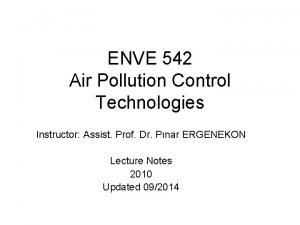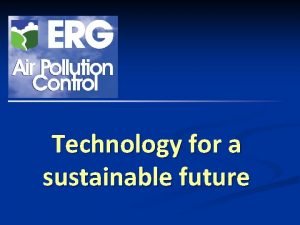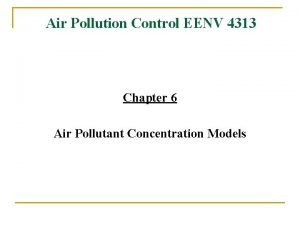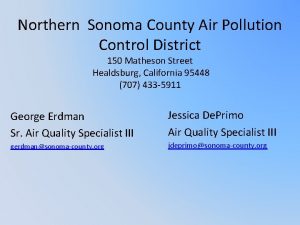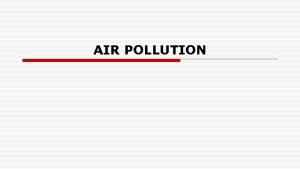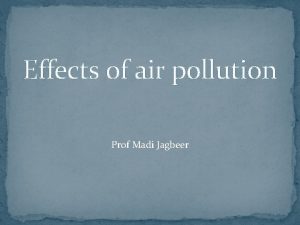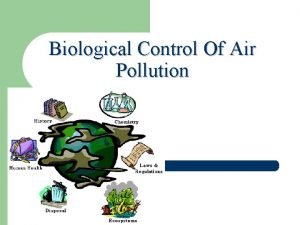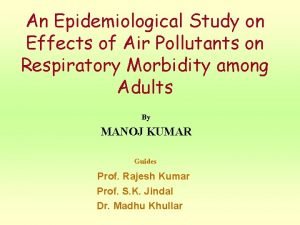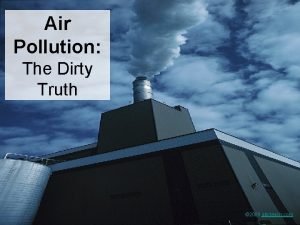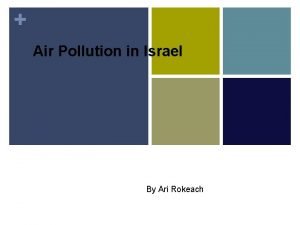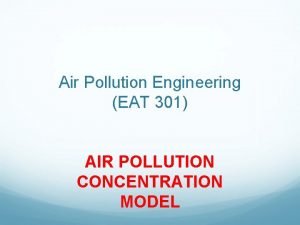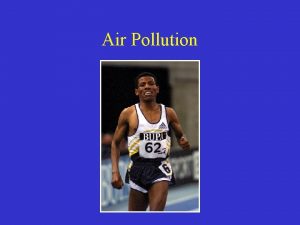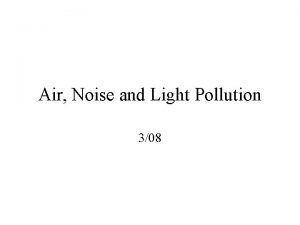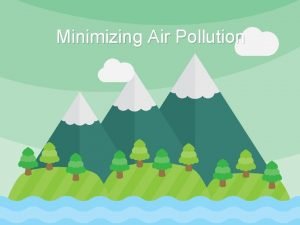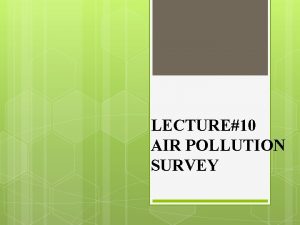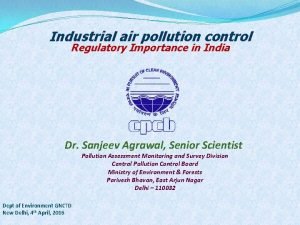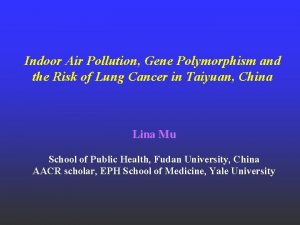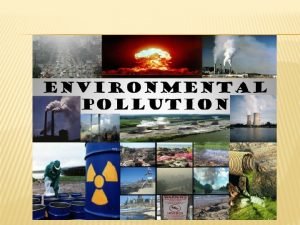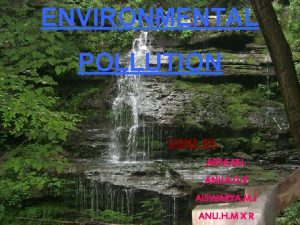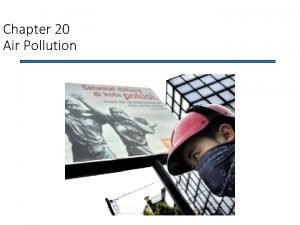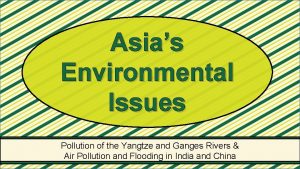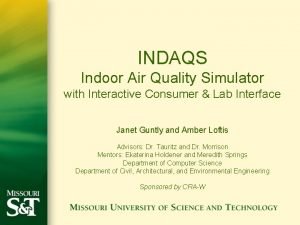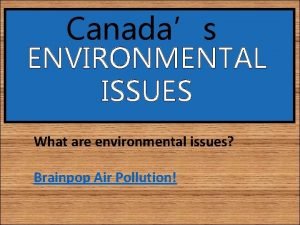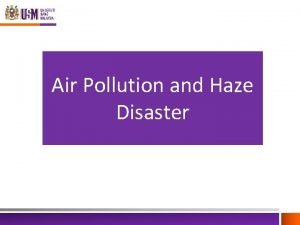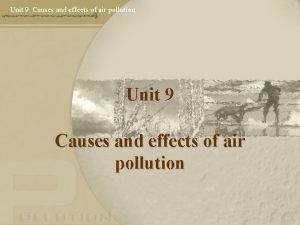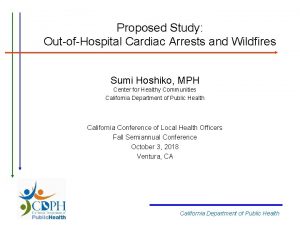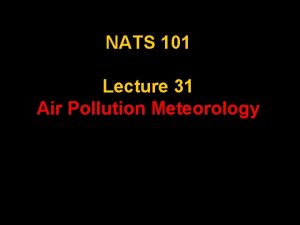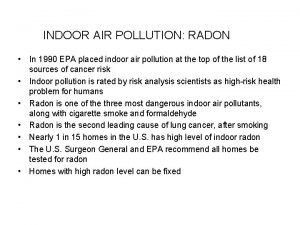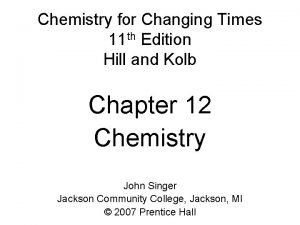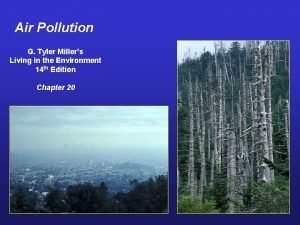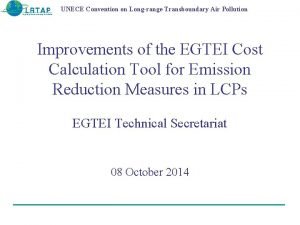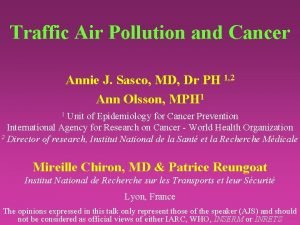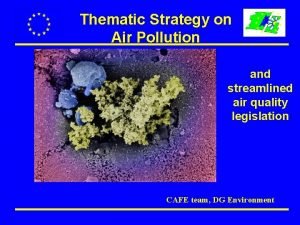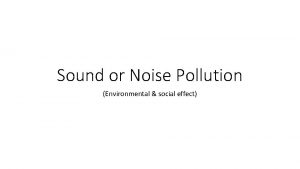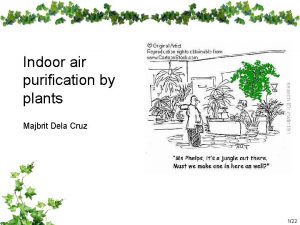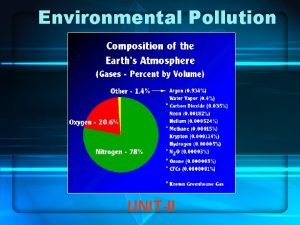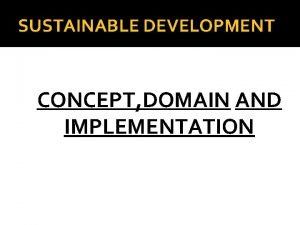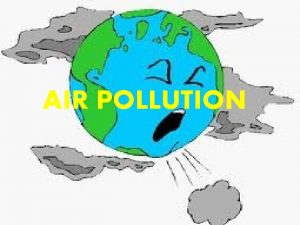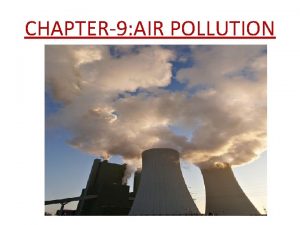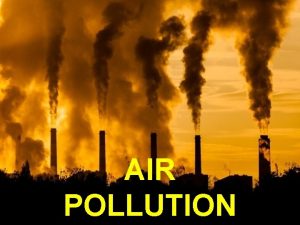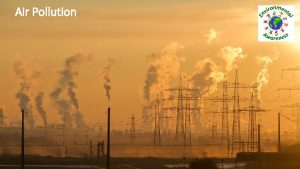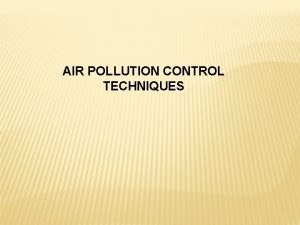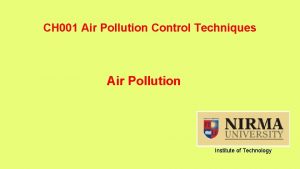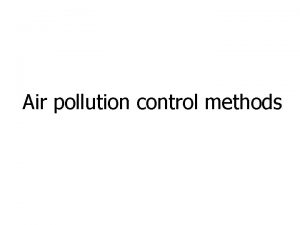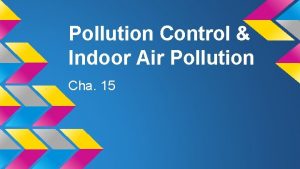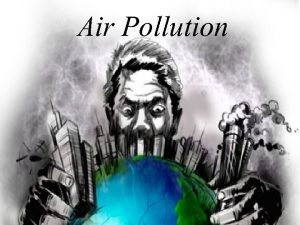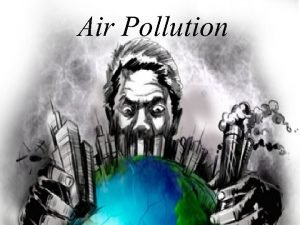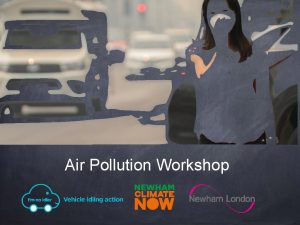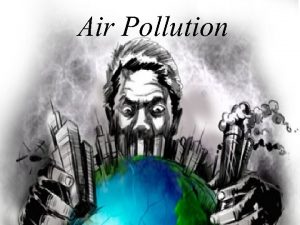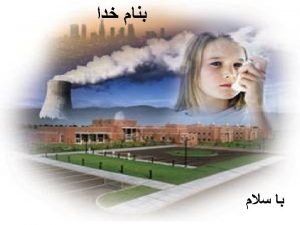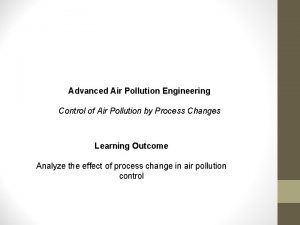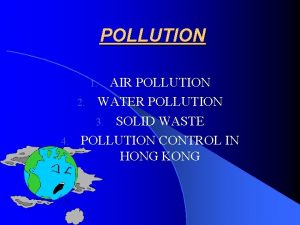TECHNOLOGY FOR AIR POLLUTION CONTROL PART 1 TECHNIQUES






















































- Slides: 54

TECHNOLOGY FOR AIR POLLUTION CONTROL – PART 1

TECHNIQUES WITHOUT USING EMISSIONS CONTROL DEVICES Process Change Wind, Geothermal, Hydroelectric, or Solar Unit instead of Fossil fired Unit. Change in Fuel e. g. Use of Low Sulfur Fuel, instead of High Sulfur fuel. Good Operating Practices Good Housekeeping Maintenance Plant Shutdown

COMMONLY USED METHODS FOR AIR POLLUTION CONTROL PARTICULATE Cyclones · Electrostatic Precipitators · Fabric Filter · Wet Scrubbers · GASES Adsorption Towers · Thermal Incernation · Catalytic Combustion ·

SOX CONTROL

GENERAL METHODS FOR CONTROL OF SO 2 EMISSIONS Change to Low Sulfur Fuel · Natural Gas · Liquefied Natural Gas · Low Sulfur Oil · Low Sulfur Coal Use Desulfurized Coal and Oil Increase Effective Stack Height · Build Tall Stacks · Redistribution of Stack Gas Velocity Profile · Modification of Plume Buoyancy

GENERAL METHODS FOR CONTROL OF SO 2 EMISSIONS (CONTD. ) Use Flue Gas Desulfurization Systems Use Alternative Energy Sources, such as Hydro-Power or Nuclear-Power

FLUE GAS DESULFURIZATION SO 2 scrubbing, or Flue Gas Desulfurization processes can be classified as: · Throwaway or Regenerative, depending upon whether the recovered sulfur is discarded or recycled. · Wet or Dry, depending upon whether the scrubber is a liquid or a solid. Flue Gas Desulfurization Processes The major flue gas desulfurization ( FGD ), processes are : · Limestone Scrubbing · Lime Scrubbing · Dual Alkali Processes · Lime Spray Drying · Wellman-Lord Process

LIMESTONE SCRUBBING

LIMESTONE SCRUBBING Limestone slurry is sprayed on the incoming flue gas. The sulfur dioxide gets absorbed The limestone and the sulfur dioxide react as follows : Ca. CO 3 + H 2 O + 2 SO 2 ----> Ca+2 + 2 HSO 3 -+ CO 2 Ca. CO 3 + 2 HSO 3 -+ Ca+2 ----> 2 Ca. SO 3 + CO 2 + H 2 O

LIME SCRUBBING

LIME SCRUBBING The equipment and the processes are similar to those in limestone scrubbing Lime Scrubbing offers better utilization of the reagent. The operation is more flexible. The major disadvantage is the high cost of lime compared to limestone. The reactions occurring during lime scrubbing are : Ca. O + H 2 O -----> Ca(OH)2 SO 2 + H 2 O <----> H 2 SO 3 + Ca(OH)2 -----> Ca. SO 3. 2 H 2 O + (1/2)O 2 -----> Ca. SO 4. 2 H 2 O

DUAL ALKALI SYSTEM · Lime and Limestone scrubbing lead to deposits inside spray tower. · The deposits can lead to plugging of the nozzles through which the scrubbing slurry is sprayed. · The Dual Alkali system uses two regents to remove the sulfur dioxide. · Sodium sulfite / Sodium hydroxide are used for the absorption of sulfur dioxide inside the spray chamber. · The resulting sodium salts are soluble in water, so no deposits are formed. · The spray water is treated with lime or limestone, along with makeup sodium hydroxide or sodium carbonate. · The sulfite / sulfate ions are precipitated, and the sodium hydroxide is regenerated.

LIME – SPRAY DRYING Lime Slurry is sprayed into the chamber The sulfur dioxide is absorbed by the slurry The liquid-to-gas ratio is maintained such that the spray dries before it reaches the bottom of the chamber The dry solids are carried out with the gas, and are collected in fabric filtration unit This system needs lower maintenance, lower capital costs, and lower energy usage

WELLMAN – LORD PROCESS Schematic process flow diagram – SO 2 scrubbing and recovery system

WELLMAN – LORD PROCESS This process consists of the following subprocesses: · Flue gas pre-treatment. · Sulfur dioxide absorption by sodium sulfite · Purge treatment · Sodium sulfite regeneration. · The concentrated sulfur dioxide stream is processed to a marketable product. The flue gas is pre - treated to remove the particulate. The sodium sulfite neutralizes the sulfur dioxide : Na 2 SO 3 + SO 2 + H 2 O -----> 2 Na. HSO 3

WELLMAN – LORD PROCESS (CONTD. ) Some of the Na 2 SO 3 reacts with O 2 and the SO 3 present in the flue gas to form Na 2 SO 4 and Na. HSO 3. Sodium sulfate does not help in the removal of sulfur dioxide, and is removed. Part of the bisulfate stream is chilled to precipitate the remaining bisulfate. The remaining bisulfate stream is evaporated to release the sulfur dioxide, and regenerate the bisulfite.

NOX CONTROL

BACKGROUND ON NITROGEN OXIDES There are seven known oxides of nitrogen : · NO 2 · NO 3 · N 2 O · N 2 O 3 · N 2 O 4 · N 2 O 5 NO and NO 2 are the most common of the seven oxides listed above. NOx released from stationary sources is of two types

GENERAL METHODS FOR CONTROL OF NOX EMISSIONS NOx control can be achieved by: · Fuel Denitrogenation · Combustion Modification · Modification of operating conditions · Tail-end control equipment · Selective Catalytic Reduction · Selective Non - Catalytic Reduction · Electron Beam Radiation · Staged Combustion

FUEL DENITROGENATION o One approach of fuel denitrogenation is to remove a large part of the nitrogen contained in the fuels. Nitrogen is removed from liquid fuels by mixing the fuels with hydrogen gas, heating the mixture and using a catalyst to cause nitrogen in the fuel and gaseous hydrogen to unite. This produces ammonia and cleaner fuel. This technology can reduce the nitrogen contained in both naturally occurring and synthetic fuels.

COMBUSTION MODIFICATION Combustion control uses one of the following strategies: · · Reduce peak temperatures of the flame zone. The methods are : · increase the rate of flame cooling · decrease the adiabatic flame temperature by dilution Reduce residence time in the flame zone. For this we change the shape of the flame zone · Reduce Oxygen concentration in the flame one. This can be accomplished by: · decreasing the excess air · controlled mixing of fuel and air · using a fuel rich primary flame zone

CATALYTIC COMBUSTION

CATALYTIC EMISSION CONTROL

MODIFICATION OF OPERATING CONDITIONS The operating conditions can be modified to achieve significant reductions in the rate of thermal NOx production. the various methods are: · Low-excess firing · Off-stoichiometric combustion ( staged combustion ) · Flue gas recirculation · Reduced air preheat · Reduced firing rates · Water Injection

TAIL-END CONTROL PROCESSES o Combustion modification and modification of operating conditions provide significant reductions in NOx, but not enough to meet regulations. · For further reduction in emissions, tail-end control equipment is required. · Some of the control processes are: · Selective Catalytic Reduction · Selective Non-catalytic Reduction · Electron Beam Radiation · Staged Combustion

SELECTIVE CATALYTIC REDUCTION (SCR) Schematic process flow diagram – NOX control

SELECTIVE CATALYTIC REDUCTION (SCR) · In this process, the nitrogen oxides in the flue gases are reduced to nitrogen · During this process, only the NOx species are reduced · NH 3 is used as a reducing gas · The catalyst is a combination of titanium and vanadium oxides. The reactions are given below : 4 NO + 4 NH 3 + O 2 -----> 4 N 2 + 6 H 2 O 2 NO 2 + 4 NH 3+ O 2 -----> 3 N 2 + 6 H 2 O · Selective catalytic reduction catalyst is best at around 300 too 400 o. C. · Typical efficiencies are around 80 %

SELECTIVE NON-CATALYTIC REDUCTION (SNR) At higher temperatures (900 -1000 o. C), NH 3 will reduce NOX to nitrogen without a catalyst. At NH 3 : NOX molar ratios 1: 1 to 2: 1, about 40 -60%reduction is obtained. SNR is cheaper than SCR in terms of operation cost and capital cost. Tight temperature controls are needed. At lower temperatures, un-reacted ammonia is emitted. At higher temperatures ammonia is oxidized to NO.

ELECTRON BEAM RADIATION This treatment process is under development, and is not widely used. Work is underway to determine the feasibility of electron beam radiation for neutralizing hazardous wastes and air toxics. · Irradiation of flue gases containing NOx or SOx produce nitrate and sulfate ions. · The addition of water and ammonia produces NH 4 NO 3, and (NH 4)2 SO 4 · The solids are removed from the gas, and are sold as fertilizers.

STAGED COMBUSTION

STAGED COMBUSTION PRINCIPLE · Initially, less air is supplied to bring about incomplete combustion · Nitrogen is not oxidized. Carbon particles and CO are released. · In the second stage, more air is supplied to complete the combustion of carbon and carbon monoxide. 30% to 50% reductions in NOx emissions are achieved.

CARBON MONOXIDE CONTROL

FORMATION OF CARBON MONOXIDE · Due to insufficient oxygen · Factors affecting Carbon monoxide formation: · Fuel-air ratio · Degree of mixing · Temperature

GENERAL METHODS FOR CONTROL OF CO EMISSIONS · Control carbon monoxide formation. Note : CO & NOx control strategies are in conflict. · · Stationary Sources · Proper Design · Installation · Operation · Maintenance Process Industries · Burn in furnaces or waste heat boilers.

CARBON DIOXIDE CONTROL

SOURCES OF CARBON DIOXIDE Human-Related Sources Combustion of fossil fuels: Coal, Oil, and Natural Gas in power plants, automobiles, and industrial facilities Use of petroleum-based products Industrial processes: Iron and steel production, cement, lime, and aluminum manufactures Natural Sources Volcanic eruptions Ocean-atmosphere exchange Plant photosynthesis

SOURCES OF CO 2 EMISSIONS IN THE U. S. (x-axis units are teragrams of CO 2 equivalent) Source: USEPA

CO 2 EMISSIONS FROM FOSSIL FUEL COMBUSTION BY SECTOR AND FUEL TYPE (y-axis units are teragrams of CO 2 equivalent) Source: USEPA

GENERAL METHODS FOR CONTROL OF CO 2 EMISSIONS Reducing energy consumption, increasing the efficiency of energy conversion Switching to less carbon intensive fuels Increasing the use of renewable sources Sequestering CO 2 through biological, chemical, or physical processes

CONTROL OF MERCURY EMISSIONS

MERCURY EMISSIONS Mercury exists in trace amounts in Fossil fuels such as Coal, Oil, and Natural Gas Vegetation Waste products Mercury is released to the atmosphere through combustion or natural processes It creates both human and environmental risks Fish consumption is the primary pathway for human and wildlife exposure United states is the first country in the world to regulate mercury emissions from coal-fired power plants (March 15, 2005).

Types of Sources Source: Seingeur, 2004 and Mason and Sheu, 2002. Worldwide Distribution of Emissions Source: Presentation by J. Pacyna and J. Munthe at mercury workshop in Brussels, March 29 -30, 2004

CONTROL TECHNOLOGIES FOR MERCURY EMISSIONS Currently installed control devices for SO 2, NOX, and particulates, in a power plant, remove some of the mercury before releasing from the stack Activated Carbon Injection: Particles of activated carbon are injected into the exit gas flow, downstream of the boiler. The mercury attaches to the carbon particles and is removed in a particle control device Thief process for the removal of mercury from flue gas: It is a process which extracts partially burned coal from a pulverized coalfired combustor using a suction pipe, or "thief, " and injects the resulting sorbent into the flue gas to capture the mercury.

PARTICULATE MATTER CONTROL Range: 20 to 40000 mg/m**3 First step: Process control Second step: Use of collection device

INDUSTRIAL SOURCES OF PARTICULATE EMISSIONS · · Iron & Steel Mills, the blast furnaces, steel making furnaces. Petroleum Refineries, the catalyst regenerators, air-blown asphalt stills, and sludge burners. · Portland cement industry · Asphalt batching plants · Production of sulfuric acid · Production of phosphoric acid · Soap and Synthetic detergent manufacturing · Glass & glass fiber industry · Instant coffee plants

EFFECTS OF PARTICULATE EMISSIONS Primary Effects • Reduction of visibility • • • size distribution and refractive index of the particles direct absorption of light by particles direct light scattering by particles 150 micro g / m 3 concentration ~ average visibility of 5 miles ( satisfactory for air and ground transportation ) Soiling of nuisance • • • increase cost of building maintenance, cleaning of furnishings, and households threshold limit is 200 - 250 micro g / m 3 ( dust ) levels of 400 - 500 micro g / m 3 considered as nuisance

GENERAL METHODS FOR CONTROL OF PARTICULATE EMISSIONS Five Basic Types of Dust Collectors : Gravity and Momentum collectors · Settling chambers, louvers, baffle chambers Centrifugal Collectors · Cyclones · Mechanical centrifugal collectors Fabric Filters · Baghouses · Fabric collectors

GENERAL METHODS FOR CONTROL OF PARTICULATE EMISSIONS (CONTD. ) Electrostatic Precipitators Tubular · Plate · Wet · Dry · Wet Collectors · · · Spray towers Impingement scrubbers Wet cyclones Peaked towers Mobile bed scrubbers

PARTICULATE COLLECTION MECHANISM · Gravity Settling · Centrifugal Impaction · Inertial Impaction · Direct Interception · Diffusion · Electrostatic Effects


Tubular Dust Collector Arrangement for an ESP

OVERALL COLLECTION Η Ci inlet concentration Co outlet concentration Note: The smaller the particle, the lower is efficiency of removal.

PROBLEM A cyclone operates removes 75% of particulate matter fed to it. The filter is then fed to an ESP which operates with 90% efficiency. What is the overall efficiency of this particulate system?

Step 1: Assuming an initial feed of 100%, determine the percentage of the stream fed to the ESP. 100% - (100% x 0. 75) = 25% Step 2: Determine final composition after ESP. 25% - (25% x 0. 9) = 2. 5% Step 3: Determine overall efficiency hoverall = (initial – final)/ initial = 100% - 2. 5%100% = 97. 5%
 Air pollution control technology
Air pollution control technology Chapter 12 section 1 what causes air pollution answers key
Chapter 12 section 1 what causes air pollution answers key Chapter 12 air section 1 what causes air pollution
Chapter 12 air section 1 what causes air pollution Erg (air pollution control) ltd
Erg (air pollution control) ltd Air pollution box model example
Air pollution box model example Northern sonoma county air pollution control district
Northern sonoma county air pollution control district Air pollution control methods
Air pollution control methods Hubungan air tanah dan tanaman
Hubungan air tanah dan tanaman Soil pollution effects on human health
Soil pollution effects on human health Controlling measures of noise pollution
Controlling measures of noise pollution Soil pollution images diagram
Soil pollution images diagram Introduction about air pollution
Introduction about air pollution Air pollution effects to plants
Air pollution effects to plants Air pollution contents
Air pollution contents Air pollution aims and objectives
Air pollution aims and objectives Main cause of air pollution
Main cause of air pollution Secondary pollutants
Secondary pollutants Stationary and mobile sources of air pollution
Stationary and mobile sources of air pollution Air pollution box model example
Air pollution box model example General effects of air pollution
General effects of air pollution Air pollution consequences
Air pollution consequences Air pollution
Air pollution Objectives of air pollution
Objectives of air pollution Air pollutant definition
Air pollutant definition Air pollution
Air pollution Air pollution class 9
Air pollution class 9 Aims and objectives of pollution
Aims and objectives of pollution Sources of smog
Sources of smog 5 effects of air pollution
5 effects of air pollution Indoor air pollution examples
Indoor air pollution examples Air pollution simulator
Air pollution simulator Air pollution 2050
Air pollution 2050 Brainpop canada
Brainpop canada Air pollution
Air pollution Air pollution
Air pollution Air pollution wildfires
Air pollution wildfires Air pollution
Air pollution Radon indoor air pollution
Radon indoor air pollution Air pollution
Air pollution Prevention of indoor air pollution
Prevention of indoor air pollution Air pollution
Air pollution Air pollution wildfires
Air pollution wildfires Air pollution
Air pollution Conclusion of air pollution
Conclusion of air pollution Conclusion of air pollution
Conclusion of air pollution Air pollution specialist
Air pollution specialist Air pollution
Air pollution Sound pollution conclusion
Sound pollution conclusion Natural resources photos
Natural resources photos Mobile source definition
Mobile source definition Adjectives for air pollution
Adjectives for air pollution Indoor air pollution sources
Indoor air pollution sources Air pollution causing “dead area of leaf” is called
Air pollution causing “dead area of leaf” is called Baghouse filter definition apes
Baghouse filter definition apes Air pollution definition
Air pollution definition
